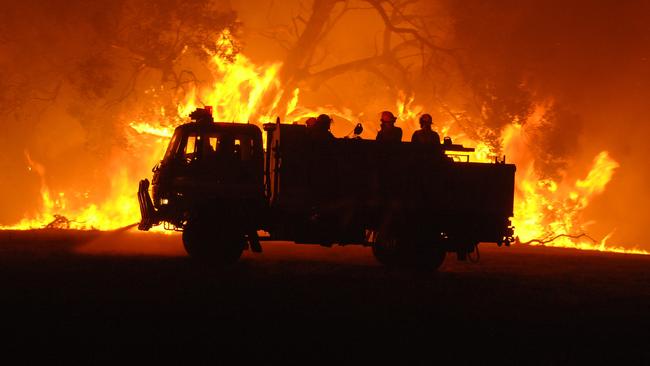Bushfire survival guide: Where to go, what to take, how to protect your property and avoid heat
SA is facing extreme fire conditions this week. Here is a guide to surviving a scorcher.
SA News
Don't miss out on the headlines from SA News. Followed categories will be added to My News.
MAKE A PLAN TO SURVIVE
Go online to cfs.sa.gov.au and create your essential plan of what you will do in the event of a fire.
PLAN TO LEAVE EARLY
Leaving early means leaving before your chosen escape route is compromised by fire and smoke, or by strong winds that may bring down trees and power lines, well before the fire arrives.
The only way to guarantee this is to leave before a bushfire even starts – the night before or early in the day of a forecast fire danger day.
WHEN TRAVELLING IN A BUSHFIRE RISK AREA ALWAYS:
■ Check weather conditions before leaving
■ Stay alert for smoke
■ Don’t drive towards smoke
■ Always carry water
■ Listen for warnings on ABC or local radio
■ Where to go: Bushfire Safer Places in SA
Check the CFS website (cfs.sa.gov.au) for the list of “bushfire safer places” and “last resort refuges” that offer relative safety. It is important that you know what each of these are, where they are and what risk you may be exposed to if you use one of these options during a bushfire.
IF YOU GET CAUGHT BY A BUSHFIRE:
■ Don’t get out of the car and run
■ Protect yourself from heat.
■ Pull over into a burnt or clear area
■ Close windows and vents and put on hazard lights and headlights
■ Get down below window level and shelter under woollen blankets

HOME SURVIVAL KIT
Protective clothing, mop, gloves, torch, hoses, shovel, towels, buckets, safety goggles, ladder, medications, bottled drinking water, fire extinguishers, battery-operated radio, spare batteries, smoke mask, woollen blankets, first-aid kit.
RELOCATION KIT IF YOU LEAVE
Protective clothing for the whole family, battery-operated radio and spare batteries, safety goggles, mobile phone and charger, medications, wallet or purse and money, bottled water (enough for each family member), clothing (two sets of clothes for each family member), identity information (passports, birth certificates), family and friends’ phone numbers, items of importance (eg. family photos, valuables, documents), blankets (durable fibres), children’s toys.
SAFEGUARD YOUR HOME
Garden
■ Clear leaf litter and other fine fuels around the house.
■ Mow lawn
■ Remove flammable material within 20m of the house, or use pathways and gravel areas to provide fuel breaks
■ Trim lower tree limbs.
■ Move woodpiles away from house
■ Regularly maintain firefighting equipment (hoses, pumps, generators, mechanical devices)
■ Use nonflammable materials for fencing, pergolas and lattice such as metal or brick
■ Ensure you have a sufficient water supply (5000 litres minimum; at least 22,000 litres if you are planning on using a sprinkler system)
House
■ Install metal screens or flywire on windows to protect against embers and radiant heat
■ Solid core doors with metal flywire screens; nonflammable draught excluders and pet doors
■ Regularly maintain external timber cladding and seal any gaps
■ Protect evaporative airconditioners with metal flywire screens
■ Cover all external vents and crevices with metal flywire screens
■ Pergolas should be made of nonflammable materials or be well wetted down
Roof
■ Clean leaves and debris out of gutters; fit leaf guards to prevent leaf build-up
■ Install non-combustible firescreens over external skylights
■ Consider installing a sprinkler system to help defend against radiant heat and embers
Veranda
■ Remove flammable items such as paper, boxes, crates.
Shed
■ Store fuel supplies away from house, preferably in a clearly marked shed
STAY INFORMED
■ Take heed of the daily fire danger ratings for your district (cfs.sa.gov.au)
■ Listen to local radio. Check your batteries and keep the radio handy
■ For current bushfire warnings, advice messages and general information follow the CFS on Facebook and Twitter
■ Do not rely on one source of information to stay bushfire safe
■ The Bushfire Information Hotline is 1300 362 361 (TTY 133 677)
SA HEALTH HEAT ADVICE
■ Drink plenty of water
■ Stay cool with a fan or airconditioner
■ Avoid going out in the hottest part of the day
■ Keep curtains, blinds and windows closed during the day to keep your home cool
■ Cool off with a shower or bath
■ Look out for family, friends and the elderly
■ If you go outside during the day, wear loose-fitting, long-sleeved and light-coloured clothing, a hat, sunglasses and SPF30+ sunscreen
